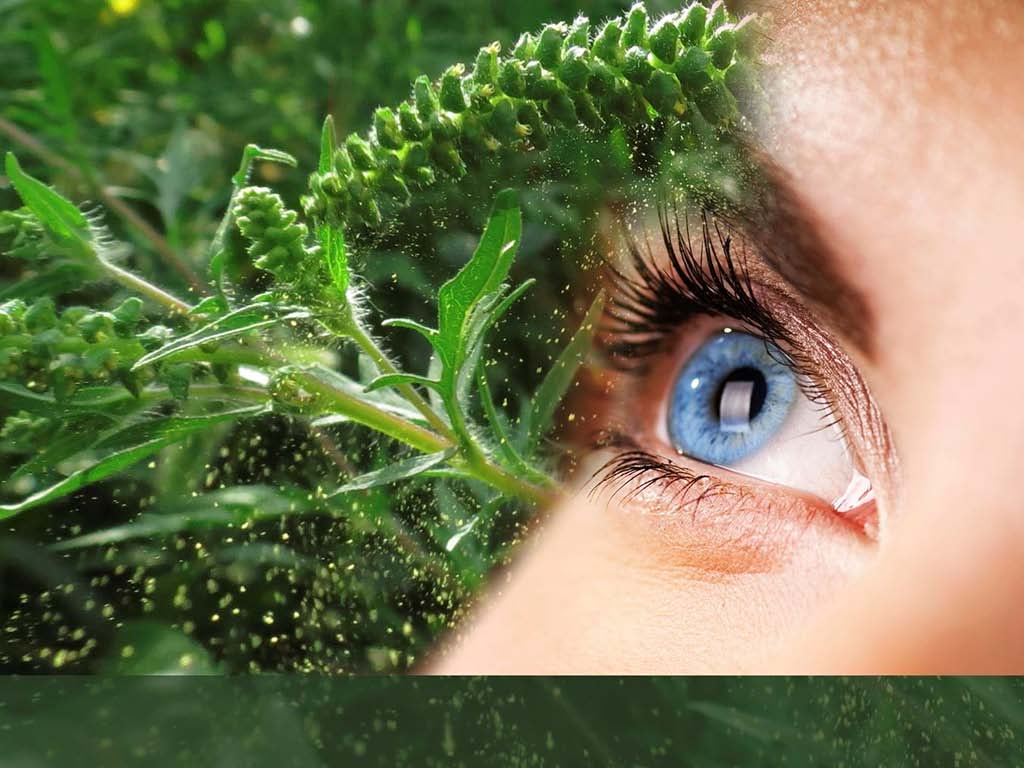Managing the spectrum of signs and symptoms for allergic conjunctivitis patients


William J. Faulkner, M.D.

Dr. Faulkner is a consultant for :
Al ergan Bausch & Lomb Physicians Recommended Nutriceuticals

Allergy: An Altered Immune Response
From the Greek words "allos" meaning different or
And "ergos" meaning work or action…an "altered
Normal response to exposure to foreign substance is
production of IgM, IgA, IgG and elimination of foreign
Allergic individual recognizes foreign substance, becomes
sensitized (can take days to years), then on re-exposure
over produces IgE which triggers activation of mast cells
and release of various inflammatory chemicals.

Allergy Relevance
Sixth leading cause of chronic disease in the US Annual economic impact: $14.5 billion Absenteeism and productivity loss: $700 million

Al ergy Target Organs
Eyes: itching, redness, tearing Nose: discharge, sneezing Skin: eczema Lungs: asthma

Managing the Spectrum
of Signs and Symptoms
Al ergic Conjunctivitis
Patients
William J. Faulkner, MD
Cincinnati Eye Institute

Prevalence of Allergic Disease
30-50% of population Ocular symptoms present in 40-60% of al ergic
Ocular Allergies Affect Many in the US
70%–80% of people affected by allergies
report ocular symptoms1
Up to 40% of the US population is affected
by al ergic conjunctivitis2
Seasonal and perennial al ergic
conjunctivitis account for 95% of all
ocular allergy cases in the US3
More than 41 mil ion bottles of OTC
and 4 million bottles of prescription
anti-allergy ophthalmic medications
are consumed annual y4
OTC=over the counter.
1. Abelson MB et al. Curr Al ergy Asthma Rep. 2011;11:205-211. 2. Bielory L and Friedlaender MH. Immunol Al ergy Clin North Am. 2008;28:43-58, vi. 3. Butrus S and Portela R.
Ophthalmol Clin North Am. 2005;18:485-492. 4. Slonim CB and Boone R. Formulary. 2004;39:213-222.
Prevalence of Allergic Conjunctivitis
The prevalence of allergic conjunctivitis has steadily increased
over the last 40 years
About 20% of the general population is effected by al ergic
conjunctivitis • 88% of people with al ergic conjunctivitis experience ocular itching
Allergy seasons are lasting longer
• From 1995 to 2009, the length of the ragweed pol en season increased by up
Al ergan Lastacaft
Allergy: Increasing Incidence
Reduced allergen exposure in childhood Genetic influence Increasing industrialization & pollution Medications and contact lenses
Allergic Response: Multiple Inflammatory Mediators
Early Phase (0‒1 h)
Late Phase (4‒24 h)
Allergen
Mast Cel s Eosinophils
Histamine
Cytokines Cytotoxic Proteins
Redness Chemosis
Chemosis Pain/Itch Discharge
LTs=leukotrienes; PAF=platelet-activating factor; PGs=prostaglandins.
1. Slonim CB and Boone R. Formulary. 2004;39:213-222. 2. Irkec MT and Bozkurt B. Curr Opin Al ergy Clin Immunol. 2012;12:534-539.
Allergic Eye Disease
Symptoms & Signs
#1: itching, especially over the caruncle Others: burning, stinging, redness, photophobia, tearing Usually bilateral, possible symmetric Chemosis aggravated by rubbing Clear or ropy discharge (mucoid) Punctal gape
Diagnostic Dilemmas in
Ocular Surface Inflammatory Disease
Key symptoms:
Allergy- itching inner
Blepharitis-burning Conjunctivochasis-pain on
touch or down gaze
Dry Eye-Discomfort
Personal, family history & exam Skin testing: Prick method more sensitive & comfortable
than intradermal
Conjunctival scraping positive for eosinophils (present in
Diagnosis - Doctor Rx
Disposable test kit, 1000 test included, $4800 6 applicators per patient x 10 al ergens = 60 Prick testing for 60 antigens performed by assistant Results within 10 minutes Potential y useful for OSD pts, IOL & Lasik pts
Diagnosis - Doctor Rx
Diagnosis - Doctor Rx
Ocular Allergy – Five categories
1. Seasonal & perennial allergic conjunctivitis…common 2. Vernal keratoconjunctivitis…rare 3. Atopic keratoconjunctivitis…3% of population 4. Giant Papillary conjunctivitis…usually contact lens
5. Contact allergic conjunctivitis…2⁰ to medications or
1. Allergic Conjunctivitis
An IgE medicated hypersensitivity condition that is characterized
by ocular pruritus and epiphora
Ocular itching is the most common symptom of allergic
Proper diagnosis is determined most often by history and physical
1. Seasonal Allergic Conjunctivitis – 22% of Population
Spring: tree & flower pollen (Easter) Summer: grass pollen (Memorial Day) Fall: ragweed (Labor Day) Maximum pollen count: 5AM-10AM Worst city in US this spring: Louisville, KY
1. Perennial Allergic Conjunctivitis
Year round symptoms, 79% have seasonal exacerbations Common culprits: animal dander, dust mites, feathers,
Often perennial rhinitis Symptoms same as SAC, also chemosis, possible dellen
3. Atopic Keratoconjunctivitis
3.Atopic Keratoconjunctivitis
Severe allergic often all year, chronic Often thickened lids, hyperemia, PEK, tarsal papillae Atopic dermatitis in 3% of population…perhaps ½ of
these have ocular involvement; + family history
ITCHING, watery, mucous discharge, red, blurry,
pain, photophobia
Skin scaly, "woody"…possible cicatricial ectropion,
lagophthalmos, keratitis, loss of vision
Pathophysiology: type I & IV hypersensitivity
3. Atopic Keratoconjunctivitis
Progression of multiple allergic sequellae Allergic conjunctivitis, atopic dermatitis, rhinitis,
asthma…? Co-manage
Immunotherapy (formerly injections) now possible with
sublingual allergen delivery (SLIT)
5. Contact Dermatitis / Conjunctivitis
5. Drug Induced Allergic Conjunctivitis
Itching, inferior conjunctival injection, lower lid
dermatitis, possible keratitis
Stop med for 2 weeks….? Test for al ergy type Rechallenge with drop, immediate symptoms= Type I
Irritation after 48-72 hrs = Type IV cell mediated reaction Possible culprits: Neomycin, Brimonidine, preservatives,
other antibiotics
5. Contact Allergic Conjunctivitis/Dermatitis
Type IV delayed hypersensitivity reaction (T cell-
Often due to chemicals in everyday products, usually
Erythema, swelling, dryness, pruritis, possible vesicles,
scaling & lichenification, thickened skin
Look at hands…nail polish (formaldehyde) or glue
5. Contact Dermatitis / Conjunctivitis
5. Contact Allergic Conjunctivitis/Dermatitis
Gold…remove and avoid jewelry Fragrance…perfumes, colognes, soap, shampoo, fabric
softeners, cleaners
Balsam of Peru…additive in multiple products Nickel…glasses frames, eyelash curler, eye make
up…even door handles, car keys, zippers & buttons
Benzalkonium chloride
5. Contact Allergic Conjunctivitis/Dermatitis Questions
1. Have you used any new products on eyelids, face or scalp? 2. any prescription or OTC products on face? 3. When did you last buy new makeup? 4. Any recent travels?
Allergy testing may be indicated if answers are elusive
Treatment Basics
Avoid allergens: No pets in bed, close windows, take up
carpet, HEPA filter, special mattress cover
After exposure, wash hands, face, shower to wash hair
Cold artificial tears and cool compresses Saline nasal rinse or spray Avoid rubbing eyes or blotting with tissue Disposable contact lenses
Patients can determine local allergens by entering their
Patients should identify when their SAC allergy seasons
starts and peaks and start treatment 1 week prior
If allergy is only ocular, avoid oral antihistamines due to
drying side effect (except Montelukast, Singulair)
Pollen counts highest in morning & early evening Glasses or goggles can minimize allergen load Allergist may recommend immunotherapy, the only Rx
which is disease altering
Artificial Tears
Non-preserved is safest Newer transient preservative acceptable for use 4x/day Drops containing purite, polyquad, sorbic acid, sorbitol
Treatment: Combination Mast Cel
OTC Ketotifen, including Alaway (Bausch & Lomb) and Zaditor
Rx Bepotastine (Bepreve, Bausch & Lomb), Alcaftadine (Lastacaft,
Allergan), Olopatidine (Pataday, Alcon), …no 3 way comparison
Bepotastine, BID dosing, 5 or 10 ml bottle, 68% had no itching
after 3 minutes, 0.005% BAK, "comfortable", selectively inhibits
histamine H1 receptor, ↓ rhinitis
Alcaftadine, 1x/day, 3 ml, 0.005% BAK, works within 3 minutes,
lasts 16 hours, ↓ chemotaxis & eosinophil activation, only
Pregnancy B (studied & no SE found)
Olopatidine, 1x/day, 2.5 ml, 63% had no itching after 3 minutes,
0.010% BAK, old formulation , best insurance coverage
2014 Mast Cell/Antihistamine Rx Drops
PATADAY – Insurance Coverage
Inflammation: Role of Steroids
Progenitor Cel Proliferation
Topical Steroids
Mast Cell
Work Here
Topical Steroids
Phospholipase A2
Work Here
Arachidonic Acid
Cyclic Endoperoxides
Histamine
Prostacyclin Thromboxane A2
(LTB4, LTC4, LTD4, LTE4)
(PGD2, PGE2, PGF2)
PAF = platelet-activating factor.
Adapted with permission from Donnenfeld ED. Refract Eyecare. 2005;9(suppl):12-16.
Treatment: Steroids, topical
Inhibit multiple foci in inflammatory cascade, highly
May be unnecessary for SAC & PAC Side effect profile well known; cataract, ↑ IOP,
↑infection risk
Hydrocortisone 1% cream to skin, short term SE minimized with ester or "soft steroid" Lotoprednol, 0.2% (Alrex), 0.5% (Lotemax drops, gel, or
Safety of Steroids?
Lotoprednol, 0.2%, used in 397 patients for SAC or PAC
159 patients with continuous use 2-4 x/day > 1 yr some
No reported adverse effects, ester base vs ketone steroid Ilyas, et.al, EYE & CONTACT LENS, January, 2004
Lotemax Ointment
First new monotherapy steroid ointment in US in over 20
First preservative free steroid ointment in US On label for post op inflammation s/p cataract surgery Bonus benefit for patient with dry eye Option is off label use with bleph/DES patient…a 1-2 punch
Also reuse medication in patient on Azasite still symptomatic SE profile much more benign than other steroids…potency
Another possible indication: HSV immune stromal keratitis
Treatment: NSAID's topical
Ketorolac (Acular), approved indication; Diclofenac
Postroglandin inhibitor decreases itching Stinging or burning in 40%, not first line treatment
Treatment: Severe Cases: Immunomodulators
Cyclosporin, 0.05% (Restasis)…T cell inhibitor Tacrolimus (Protopic) ointment Pimecrolimus (Elidel) cream Safe for long term use on skin, effective but expensive
Atopic Treatment-Tacrolimus
Tacrolimus (Protopic) ointment, 0.1 or 0.3% Macrolide immunosuppressant inhibits T lymphocytes
FDA approved 1994, systemic use for organ transplants,
On label for atopic dermatitis on skin Off label used in conjunctival fornix BID Reported case of resolution of symptoms in 2 months
after failure on all of above; tapered uneventfully over 4
months…no side effects
Atopic Treatment
Coordinate with allergist, environmental
Antihistamines, mast cell stabilizers,
cyclosporin, steroids, surgical resection of or
cryo of papillae
Treatment Failures
Undiagnosed blepharitis and/or dry eye Eczema (skin al ergy…present on flexor surface of arms &
legs) • Itchy lids > itchy eyes • Stop rubbing, stop soap, water & scrubs • Short course hydrocortisone cream (0.5 or 1%) or Lotoprednol
• Consider…Dermatology consult
Demodex: diagnosis = cylindrical dandruff
Blepharitis – Demodex – cylindrical dandruff
New Rx: Allergic Rhinitis
• Stallergenes (France), FDA approved April 2, 2014,
age 10-65 for 5 grass pol ens, sublingual qd, start
•Merck, FDA approved April 14, 2014, for
Timothy grass pollen, age 5-65,
sublingual qd, start 12 weeks before
•Merck, Sharp & Dohme, FDA approval April 17, 2014,
age 18-65 for ragweed pol en, sublingual qd.
Nasacort Now OTC
Allergy: Summary
Avoidance…An ounce of prevention… Stop the rub to fix the itch New medications are highly effective
Source: http://www.cincinnatieye.com/wp-content/uploads/2014/05/0e846b6ba99271b338c2a25d9a4df217.pdf
SECURITY DETAILS Pages: 1 to 7 VINFERMATON (SPECIAL COCKROACHES) ISSUE DATE: 09/09/2004 SECURITY DETAILS Complying with de European Committee 91/155/EEC, last modification 2001/58/EC (07/27/01) and R.D. 255/2003. 1. IDENTIFICATION OF THE SUBSTANCE/PREPARATION AND OF THE COMPANY. Name of the product: VINFERMATON (SPECIAL COCKROACHES)
PLM®EDICIÓN 12 0 1 1 dasideb Oe díauG Guía de Manejo de Claudia Milena Gómez Giraldo Médica cirujana, Universidad de Caldas, Manizales. Especialista en medicina interna, Universidad del Valle, Cali. Especialista en endocrinología, Pontificia Universidad Javeriana, Bogotá. Endocrinóloga Hospital Universitario San Ignacio, Bogotá







